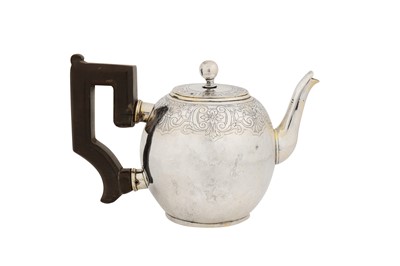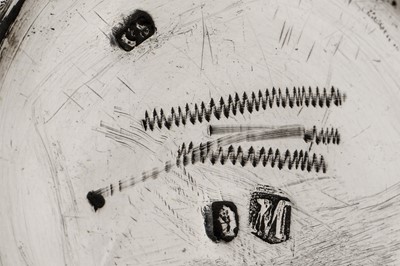11th Oct, 2023 11:00
Silver and Objects of Vertu
An extremely rare early 19th century Maltese silver teapot, Valetta circa 1800 by Vincenzo Said (reg. 1800)
An extremely rare early 19th century Maltese silver teapot, Valetta circa 1800 by Vincenzo Said (reg. 1800)
French Occupation period. In the French style, of globular form upon a collet foot, the curved spout opposite the original angular section fruit wood handle pinned to tubular sockets. The pull-off gently domed lid surmounted by a ball finial. The upper section of body with engraved decoration of foliate scrolls, stylised shell forms and acanthuses against a matted ground. The lid with a flat chased stepped strapwork brand with pellets, against a matted ground. Gilt interior, traces of gilding to the exterior. Marked underneath with maker’s mark VS (Farrugia 194), hand mark, and a M for Maltese 875 standard (Farrugia 25b) and three assay scraps. The lid with French ET import mark only (unguaranteed objects Paris 1864-1893).
Length – 17.3 cm / 6.9 inches
Height – 11 cm / 4.25 inches
Weight – 299 grams / 9.61 ozt
This extremely rare example of a Maltese teapot, a country known for its production of coffee pots, comes from the short-lived French occupation of Malta from 1798-1800. This example approximates in size and form the porcelain teapots of the Sèvres manufactory (théière calabré). Teapots are considered to have been introduced in Malta from the period of British rule in 1801. In Farrugia, J., (1992). Antique Maltese Domestic Silver, Valetta: Said International. P.64 a potential example of an 18th century Maltese teapot which was sold Sotheby’s New Bond Street, March 1986, lot 241, however this example has not been confirmed for modern publications. Also, a teapot with worn Rohan period marks is illustrated Bologana, A, A., (1995) The Silver of Malta. Malta: MAG Publications, p.122. Thereafter the earliest teapot published is a British style Ball period (1800/01-09) example (ibid, p.65). The marks of Maltese silver can be somewhat problematic between 1797-1801. Examples of Old English pattern flatware including those with crests are found with marks understood to end in 1797, a pattern naturally associated with the British. This teapot bears a slanted M, published for use in the French occupation, but also the open hand which is thought to have started from the Ball period only, although an uncertain example from the period between French and British occupation is illustrated (ibid 26a). Given that the Siege of Malta collapsed in August 1800 and this maker registered in that year it would indicate this teapot was commissioned by a high ranking French official in the early part of 1800 and thus represents an extremely rare surviving example of French occupation silver produced on the island.
Four examples of silver marked for Vincenzo Said including two coffee pots, have been noted in Bologana, A, A., (1995) The Silver of Malta. Malta: MAG Publications, p.269.
The beginning of the British period
The capture of Malta gave control of the central Mediterranean to Britain and was an important step in the invasion and liberation of Egypt from French rule in 1801. In 1801 Alexander Ball was replaced as Civil Commissioner by Charles Cameron. The Maltese leaders petitioned Ferdinand IV of Sicily to transfer his sovereign rights over the Maltese Islands to George III of Great Britain. The Peace Treaty of Amiens (March 1802) between Britain and France however the Maltese leaders were not happy with the conditions of the treaty. Their reaction came in June 1802 when they met and drafted the Declaration of Rights of the Maltese Islands and its Dependencies. In this document, the Maltese declared their ancient rights and the way they wanted to be governed by the British. The document was given to Charles Cameron, Civil Commissioner, who presented it to the King. In May 1803 the war between Britain and France started again. The British then decided to stay in Malta. The British had by then recognized the strategic position of Malta as a naval base for the British fleet in the Mediterranean.
Sold for £5,500
Includes Buyer's Premium
Do you have an item similar to the item above? If so please click the link below to request a free online valuation through our website.









